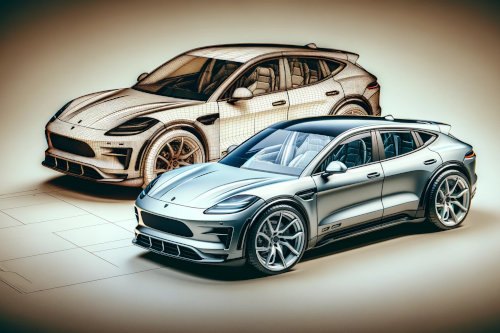The evolution of digital twins is a fascinating journey that began not in the boardrooms of the world’s leading tech companies, but rather within the confines of space exploration agencies.

The origins of the digital twin concept can be traced back to the early 2000s, when NASA pioneered the use of comprehensive, physics-based simulation models of spacecraft for testing and analysis. These models, which were essentially full-scale virtual replicas, or “mock-ups,” of spacecraft, allowed engineers to simulate conditions in space and predict how the spacecraft would perform, making them the precursors to modern digital twins.
The NASA Connection
NASA’s innovative approach was born out of necessity. Space missions are, by nature, high-stakes endeavors where the margin for error is virtually nonexistent. The physical testing of spacecraft in conditions that perfectly mimic space is impractical, if not impossible. Thus, NASA turned to virtual modeling as a solution.
The agency developed detailed digital simulations of its spacecraft, which could interact with virtual models of the space environment. These simulations enabled engineers to study the behavior of spacecraft in a variety of scenarios, leading to safer and more reliable missions.
The Agent of Change: IoT, Big Data, and AI
As significant as it was, the impact of digital twin technology was initially confined to the aerospace sector. This began to change with the technological advances of the late 2000s and early 2010s, particularly with the advent of the Internet of Things (IoT), big data analytics, and artificial intelligence (AI). These technologies provided the tools needed to collect, process, and analyze large volumes of real-time data from physical objects, making the application of digital twins feasible across a broad range of industries.
IoT
The proliferation of IoT devices has been a critical factor in the expansion of digital twin technology. IoT sensors and devices can monitor the state of a physical object or system in real time, collecting data on everything from temperature and pressure to location and movement. This data feeds into the digital twin, keeping the virtual model continuously updated with the latest information from its physical counterpart.
This seamless integration of real-time data is what allows digital twins to simulate, predict, and optimize the performance of physical objects so effectively.
Big Data and AI
Big data and AI have also played pivotal roles in the evolution of digital twins. The sheer volume of data generated by IoT devices requires advanced data analytics capabilities to process and make sense of it.
AI and machine learning algorithms can analyze this data, identifying patterns and predicting outcomes with a high degree of accuracy. This capability allows digital twins to not only mirror the current state of their physical counterparts but also forecast future states and potential problems.
Beyond Space: The Expansion into Various Industries
Today, the use of digital twins has transcended its initial aerospace confines, permeating a diverse array of sectors, each leveraging the technology to solve unique challenges and enhance efficiency.
Manufacturing
In manufacturing, digital twins serve as the backbone of the fourth industrial revolution, enabling companies to create a virtual mirror of their production lines. This virtual mirror allows for real-time monitoring and simulation, offering insights that help in optimizing operations, reducing energy consumption, and minimizing waste. Predictive analytics powered by digital twins can forecast equipment malfunctions before they occur, drastically reducing downtime and maintenance costs.
By simulating changes in production processes, manufacturers can evaluate the impacts of adjustments in a risk-free environment, thereby supporting continuous improvement and innovation.
Healthcare
In the realm of healthcare, digital twins mark a paradigm shift in personalized medicine and surgical planning. Digital replicas of organs or even entire physiological systems can be created for patients, allowing medical professionals to diagnose conditions with greater accuracy and plan treatments or surgeries with higher precision.
For instance, a digital twin of a patient’s heart can simulate how it responds to different treatments, guiding doctors towards the most effective interventions. This not only improves patient outcomes but also significantly reduces the trial-and-error aspect of medical treatments.
Urban Planning
Similarly, in urban planning, digital twins of cities offer unprecedented opportunities for optimizing traffic management, energy distribution, and infrastructure development. These virtual models can simulate the impact of various scenarios, from natural disasters to large-scale public events, enabling planners to devise strategies that enhance urban resilience, sustainability, and livability.
Automotive
The automotive industry, too, benefits from digital twins in designing vehicles that are safer, more efficient, and better suited to the needs of the future. By testing vehicle designs and systems virtually under a wide range of conditions, manufacturers can identify potential issues early in the design process, saving time and resources while pushing the envelope of automotive innovation.
Each of these examples underscores the transformative power of digital twins, demonstrating their capacity to revolutionize industries by providing deep insights and predictive capabilities. Beyond their current applications, the potential for digital twins is limited only by the imagination.
As technology continues to advance, so too will the capabilities of digital twins, offering ever more sophisticated tools for solving the complex challenges of our time. This evolution promises not only greater efficiency and innovation across industries but also the potential for profound societal benefits, from improved health outcomes to more sustainable and livable cities, marking a new era of digital and physical integration.
Conclusion
The journey of digital twins from specialized tools for space missions to ubiquitous elements of modern business and technology underscores their significance as a paradigm-shifting innovation. What began as a novel solution for the unique challenges of space exploration has grown into a fundamental technology that enhances decision-making, efficiency, and innovation across countless fields.
As we continue to push the boundaries of what digital twins can achieve, their origins remind us of the boundless potential of human ingenuity when faced with the vast unknown, whether it be the depths of space or the complexities of our digital future.


